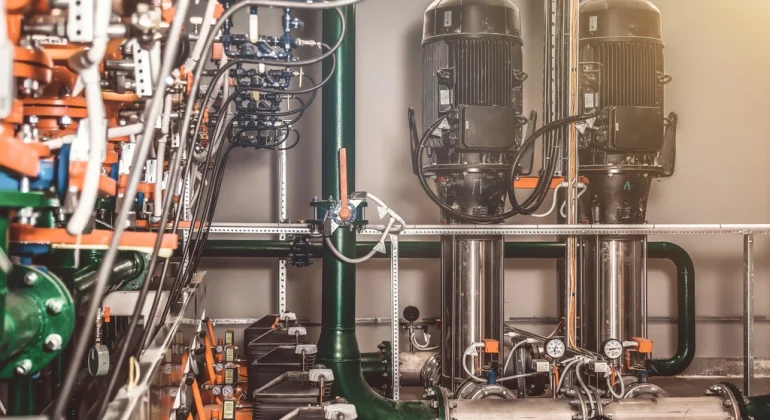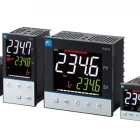Pressure transmitters are vital components in many industries that require precise pressure measurement, such as manufacturing, water and waste management, power generation, aerospace and aviation, automotive, and so much more.
From monitoring pressure in pipelines to controlling systems in manufacturing plants, understanding how these transmitters work can help businesses optimize operations.
What is a Pressure Transmitter?
A pressure transmitter is a device that is capable of measuring pressure in liquids, gases, or steam and converts it into an electrical signal. These signals are essential for monitoring and controlling industrial processes. It can sometimes be referred to as a transducer.
A pressure transmitter typically has a compact and durable design, though the size can vary depending on the application and type.
Most of these transmitters are small to medium-sized, roughly the size of a handheld device or a soda can. They are designed to fit into tight spaces in industrial systems. They usually have a cylindrical or rectangular body with ports for connecting to pipelines or tanks and terminals for electrical connections.
These transmitters are primarily made of stainless steel or other corrosion-resistant alloys to withstand severe conditions such as high pressure, extreme temperatures, or corrosive media. The weight can range from a few hundred grams to several kilograms, depending on the design and materials.
What are the Key Features of a Pressure Transmitter?
1. Sensing Port: Detects the pressure of the medium (liquid, gas, or steam).
2. Electrical Connections: Transmit signals to control systems or displays.
3. Compact Housing: Protects the internal components, often sealed for use in hazardous
conditions.
Why Do We Need a Pressure Transmitter?
These transmitters play a crucial role in:
- Ensuring operational safety by monitoring critical pressure levels.
- Maintaining process efficiency through accurate readings.
- Reducing downtime by detecting anomalies early.
As a real world example, in a chemical manufacturing plant, maintaining precise pressure levels in reaction vessels is crucial to ensure product quality and safety. During the production of ammonia, an industrial pressure transmitter monitors the inside of the reactor where nitrogen and hydrogen gases are combined.
The transmitter measures in real time and sends an electrical signal to the plant’s control system. If the pressure exceeds safe levels, the system can automatically adjust valves or shut down operations to prevent equipment damage or hazardous leaks. This ensures consistent production quality and maintains safety standards in the plant.
Pro Tip: Install pressure transmitters in critical systems to prevent costly breakdowns.
What is the Function and Purpose of a Pressure Transmitter?
The primary function of a pressure transmitter is to provide precise pressure measurements in real-time, which are essential for process automation and control systems. However, its purpose extends beyond measurement—it helps in decision-making by supplying accurate data to operators and control systems for optimal performance.
How Does a Pressure Transmitter Work?
Pressure transmitters work by sensing pressure changes and converting these into proportional electrical signals. The process involves three main components: a sensing element, signal processing unit, and output module.
The Three Main Components of a Pressure Transmitter
The sensing element is responsible for detecting the pressure of the medium, such as a liquid, gas, or steam. This information is then sent to the signal processing unit, which converts the raw pressure data into a usable electrical signal. Finally, the output module transmits this signal to display devices or control systems, enabling operators to monitor and manage the pressure effectively.
These components ensure the accuracy and reliability of such transmitters in industrial applications.
What is the Difference Between a Pressure Transmitter and a Pressure Sensor?
A pressure sensor measures pressure but does not process or transmit signals. On the other hand, a pressure transmitter processes the signal and sends it to a remote device for monitoring or control.
For example, in a water treatment plant, pressure monitoring is crucial to ensure that water flows smoothly through filtration systems.
A sensor might be installed directly on a pipeline to measure the water pressure as it moves through the system. The sensor detects the pressure but only provides raw data, which must be read and interpreted at the location of the sensor, such as on a local display.
In contrast, a transmitter would not only measure but also convert the data into an electrical signal and send it to a centralized control room. This allows operators to monitor remotely and in real-time. If the pressure drops due to a blockage or increases due to a pump malfunction, the control system can trigger an alarm or adjust the system automatically.
This ability to transmit signals makes transmitters more suitable for applications requiring centralized monitoring and automation.
Pro Tip: Choose a pressure transmitter over a sensor when you need remote monitoring capabilities.
Application
Categorized based on what kind of condition the sensor is designed for.
- Vacuum Pressure Sensors: Specifically designed to measure pressures below atmospheric pressure. Used in vacuum chambers, semiconductor manufacturing, and leak detection.
- Bourdon Tube Sensors (mechanical): Use a curved metal tube that straightens under pressure, moving a pointer on a dial for a visual reading. They are durable and ideal for high-pressure industrial applications like boilers and pipelines.
- Manometers (mechanical gauges): Measure using a liquid column or dial to compare against a reference pressure. They are simple, cost-effective tools for low-pressure applications such as lab experiments.
- High-Pressure Sensors: Designed to measure extremely high pressures in industrial or scientific applications. Commonly used in hydraulic presses, water jet cutting, and oil exploration.
- Low-Pressure Sensors: Engineered to detect very slight changes. Suitable for medical equipment (e.g., ventilators) and weather monitoring.
Why the Variance in "Types"?
As mentioned, pressure sensors can be classified in multiple ways (based on measurement method, technology, or application). Some sources focus on the core principles of how they work (e.g., Strain Gauge vs. Piezoelectric), while others emphasize the types of environments in which they are used (e.g., vacuum, high-pressure). Also, newer technologies (like digital pressure sensors) may be categorized separately, while older mechanical ones might be grouped into fewer categories.
There isn’t a universally agreed-upon number of sensor types because classifications can vary by source. It’s helpful to look at which categorization method is most relevant for your needs (such as measurement range, precision, or application type) when considering “types.”
What are the Advantages and Disadvantages of a Pressure Transmitter?
Pressure transmitters offer several key benefits that make them indispensable in industrial applications. However, they also come with certain drawbacks.
Advantages of a Pressure Transmitter
- High accuracy and reliability: Ensures precise measurements crucial for maintaining safety and efficiency.
- Compatibility with remote monitoring systems: Enables data to be transmitted to centralized control rooms for real-time monitoring and automated adjustments.
- Durability and suitability for extreme conditions: Built with robust materials to resist corrosion, extreme temperatures, and high pressures, making them ideal for demanding industries like oil and gas, manufacturing, and water treatment.
How to Choose a Pressure Transmitter?
Consider these several key factors to ensure that the device is suited for your specific application and operational condition.
Application Requirements
The first step is to determine the pressure range your system will operate in. Ensure that the transmitter can measure the expected pressures accurately, whether it’s for high-pressure applications like in the oil and gas industry or low-pressure applications such as in HVAC systems.
You should also assess accuracy needs—for some critical applications, you may require extremely precise measurements, while other situations may allow for a wider margin of error.
Environmental Conditions
The temperature and medium in which the transmitter will operate are crucial factors. The transmitter should be able to withstand extreme temperatures, whether it’s a freezing cold warehouse or a high-temperature industrial area.
Additionally, the transmitter’s materials should be compatible with the medium (steam, liquids, and gases) it will be exposed to, as certain chemicals or corrosive substances can damage sensitive components. For example, if the transmitter will be exposed to corrosive liquids, a stainless steel or specially coated model may be necessary.
Output Signal Type
Different systems require different signal types, so ensure that the transmitter’s output signal is compatible with your control system. Common output types include 4-20mA, 0-10V, and digital signals such as Modbus or HART. Match the output signal type with your existing monitoring and control systems to ensure seamless integration and accurate data transmission.
Pro Tip: Always verify the transmitter’s certifications for industry compliance. Depending on your industry, you may need a transmitter that meets specific certifications or industry approval such as Ex (explosion-proof), CE, UL, or ISO standards.
How to Calibrate a Pressure Transmitter?
Over time, the transmitter’s performance can drift due to factors like environmental changes, wear and tear, or electrical interference. Regular calibration ensures the transmitter continues to provide precise and accurate readings.
Here’s a step-by-step breakdown of the calibration process:
Preparation
Before starting, ensure that the transmitter is safely disconnected from any live systems. Gather the necessary equipment, including a calibration standard (such as a calibrated reference pressure source), a digital pressure gauge, and any required tools for adjustment (like a screwdriver).
Compare Output to Reference Standard
Connect the transmitter to the calibration setup, which includes the reference pressure source. Begin by applying known pressures to the transmitter across its entire measurement range. As the pressure is applied, the transmitter will generate an electrical signal, usually in the form of milliamps (for 4-20mA systems) or voltage.
Check and Record the Output
Compare the transmitter’s output against the standard readings. The readings on the transmitter’s output should match the reference values at multiple pressure points (e.g., zero, mid-range, and full-scale). If discrepancies are found between the transmitter’s output and the reference standard, calibration adjustments are necessary.
Adjust the Transmitter (if needed)
Adjust the transmitter’s internal settings (e.g., span or zero adjustments) to align the output signal with the reference pressure values. Some transmitters may have a manual adjustment screw, while others may allow adjustments via digital interfaces or software.
Re-test and Verify
After adjustments are made, reapply the pressure at various points to verify that the transmitter now provides accurate readings. If necessary, make further adjustments until the output matches the reference values.
Record Calibration Data
For documentation and compliance purposes, it’s important to record the calibration results, including the calibration equipment used, the pressure points tested, and any adjustments made. This ensures traceability and helps maintain regulatory standards.
Pro Tip: For critical applications, it’s recommended to have calibration performed by a certified calibration technician or laboratory, especially when high accuracy is required. Additionally, always follow the manufacturer’s recommended calibration intervals and procedures to avoid inaccuracies in pressure readings.
What Are the 4 Types of Pressure Transmitters?
Like pressure sensors, pressure transmitters can be categorized using different factors. Hence, the number of “types” can vary depending on how they are classified.
For this article, we’ll categorize the transmitters based on their mode of measurement, which will give us four main types:
Gauge Pressure Transmitters
Measure relative to atmospheric pressure. These are the most common type and are used in a variety of industrial applications like fluid monitoring and tire pressure measurement.
Absolute Pressure Transmitters
Measure relative to a vacuum (absolute zero pressure). They are used in applications where absolute pressure is required, such as in barometric pressure monitoring, vacuum systems, or altitude measurement.
Differential Pressure Transmitters
Measure the difference between two pressure points. They are essential in applications like flow rate measurement, filtration systems, tank level monitoring, and pressure drop calculations.
Multivariable Transmitters
Measure multiple variables, such as pressure, temperature, and flow rate, in a single unit. They are commonly used in industries like oil and gas, energy, and manufacturing to streamline operations, improve accuracy, and reduce the need for multiple instruments.
FAQs
What is a pressure transmitter 4/20mA?
This refers to transmitters with a 4-20 mA output. The output can be 4mA (minimum pressure) to 20mA (maximum pressure).
Can a pressure transmitter measure flow?
Yes, a pressure transmitter can be used to measure flow indirectly, particularly when combined with flow meters.
How often should you calibrate a pressure transmitter?
It depends on application demands but is typically done annually.
What industries use pressure transmitters the most?
Oil and gas, manufacturing, water treatment, and aerospace.
What are common issues with pressure transmitters?
Issues include signal drift, environmental interference, and physical damage, which can be mitigated with regular maintenance.
About Fuji Electric Sales Philippines, Inc.
Fuji Electric Sales Philippines, Inc., part of the Japan-based Fuji Electric Co., Ltd., manages sales, promotion, and support for Fuji Electric products throughout the country. The company’s focus is on power electronics, automation solutions, and energy-efficient technologies that help move the nation forward.
All set to upgrade your systems with Fuji Electric’s pressure transmitter? We are available to help you at every stage. Get in touch with:
Rickson Manalo
Assistant Sales Manager
0917-115 6102









